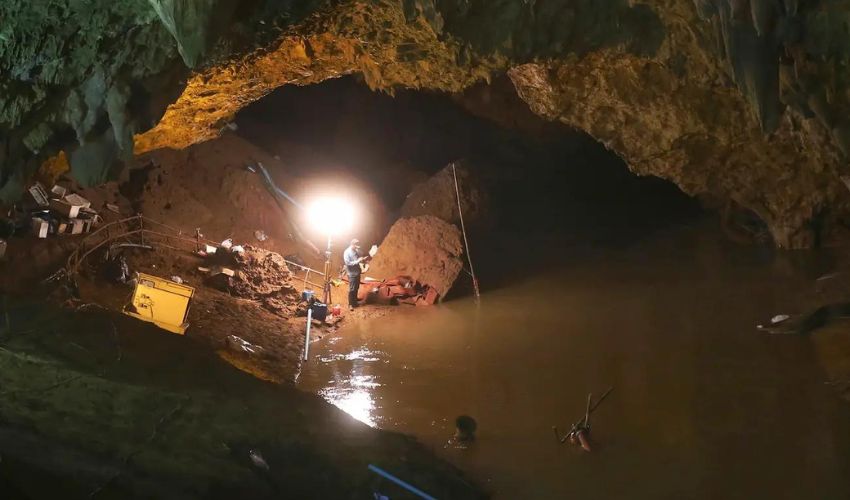3D Printed Robots to Be Used in Search-and-Rescue Operations

In Search-and-Rescue operations, timing and flexibility is often key to successful results. It is often integral not only that rescue efforts happen as quickly as possible to guarantee the maximum number of survivors in a crisis, but that responses be specialized for each specific disaster. But this can be difficult to achieve. Thankfully, there may now be a solution. Worcester Polytechnic Institute (WPI) researcher Markus Nemitz has received a $599,815 CAREER Award from the National Science Foundation to develop small and flexible, 3D printed robots that are capable of traversing challenging terrains by swimming, crawling, climbing, and diving through hostile and confined spaces as part of search-and-rescue operations.
Nemitz’s project was inspired in large part by the Tham Luang cave crisis from 2018. In the incident, 12 members of a youth soccer camp as well as their coach were trapped deep in the Tham Luang cave, a karstic cave system in Thailand, which flooded due to monsoonal flooding caused by sudden, heavy rainfall on June 23rd. The plight of the team received widespread international attention at the time due to the fact that efforts to locate the group were hindered by strong currents and rising water levels. And even after all 13 were found alive on July 2nd, over a week after entering the cave, rescue was difficult due to the narrow passages and muddy waters. Eventually, all were rescued between July 8th and 10th by an international team, with as many 10,000 people including 100 divers involved in the efforts.

Markus Nemitz has received the grant to develop custom robots for use in search-and-rescue operations (photo credits: WPI)
In order to save all 13 members of the team, innovation was key as many different rescue operation attempt options were considered. This is what has inspired Nemitz. He is working on developing these 3D printed robots with integrated fluidic circuits to see how they can be rapidly made and deployed in disasters such as in Tham Luang cave. Indeed, in the five-year project, he plans to test miniaturized models of the robots in replicated parts of the Thai cave.
Nemitz further explains the purpose of the robots, stating, “Disasters often demand unique, specialized responses, such as was required for the Tham Luang cave crisis. There lies immense potential in the development of small robots that are quickly fabricated from soft, flexible materials. These robots can significantly aid rescue efforts by exploring areas that pose potential hazards to humans or are otherwise inaccessible, including earthquake debris, flooded regions, and even nuclear accident sites.”
Making 3D Printed Robots for Search-and-Rescue Purposes
In this project, Nemitz is drawing upon his own experience with soft robotics, a field in which we are increasingly seeing the influence of 3D printing. More specifically, he is hoping to advance the fields of both soft robotics and printable robotics by developing new principles for robot design and fabrication, focusing especially on integrating electronic circuits with 3D printed fluidic circuits. These were chosen because of their resilience to mechanical damage and electromagnetic interference as compared to traditional electronics thanks to their use of pulses of air.
Moreover, it seems that the resulting robots will be relatively accessible to make. Nemitz plans on using commercial 3D printers and elastomeric filaments in order to ensure the feasibility and efficacy of these 3D printed robots. Once completed, their performance in the lab-based model cave system will be assessed by seeing how they reach designated targets. The hope is as well that the robots will be used in even more fields including in space exploration, climate monitoring and inspection operation in hostile settings.
Nemitz concludes, “Robots can go to places beyond human reach. Equipped with sensors such as microphones and cameras, these robots will enhance the capabilities of rescuers, especially during natural disasters. To ensure a dynamic and rapid response to emergencies, we must continually innovate and develop new technologies. Robotics is at the forefront of this development.” You can find out more in the press release from WPI HERE or check out the video below:
What do you think of the use of these 3D printed robots in search-and-rescue operations? Let us know in a comment below or on our LinkedIn, Facebook, and Twitter pages! Don’t forget to sign up for our free weekly Newsletter here, the latest 3D printing news straight to your inbox! You can also find all our videos on our YouTube channel.
*Cover Photo: Flood water in the Tham Luang Cave crisis during the search effort for the 12 boys and their coach (photo credits: AP Photo/Sakchai Lalit)







